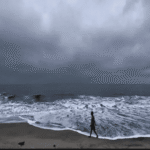U.S. powerful winter storm has wreaked havoc across the central United States, leaving Kansas and northwestern Missouri under blizzard conditions. The storm, carrying heavy snow, freezing rain, and high winds, has blanketed roadways, disrupted travel, and forced authorities to issue strong advisories against unnecessary movement. With Washington D.C. now in its path, the storm threatens to paralyze parts of the East Coast as it moves eastward.
This article provides a detailed account of the storm’s impact, warnings issued by the National Weather Service (NWS), and the ongoing efforts to manage its fallout.
The Central U.S. Under Siege
Blizzard Conditions in Kansas and Missouri
Kansas bore the brunt of the storm early, with winds reaching over 35 mph, drastically reducing visibility. Many cities, including Wichita, witnessed whiteout conditions, making roadways treacherous and leading to multiple vehicular accidents.
Northwestern Missouri saw similar impacts, with areas like St. Joseph and Kansas City reporting freezing rain turning roads into icy hazards. Snow accumulation reached more than six inches in several places, with forecasts suggesting even heavier snowfall as the storm progresses.  For the more information click on this link
For the more information click on this link
Emergency Responses
Authorities in Kansas and Missouri mobilized resources to manage the storm’s impact:
- Travel Advisories: Residents were urged to stay off the roads unless absolutely necessary, and major highways were closed in several regions.
- Shelters: Emergency shelters were set up for those stranded or seeking refuge from the extreme weather.
- Snow Removal Efforts: Local governments deployed snowplows and salt trucks, U.S. but rapid snowfall hindered their effectiveness.
Impact on Infrastructure and Daily Life
Transportation Chaos
- Roadways:
Snow and ice accumulation led to accidents on major interstates like I-70, causing significant delays. - Air Travel:
Over 1,000 flights were canceled across major airports, including Kansas City International Airport, U.S. with delays rippling throughout the national aviation network. - Railways:
Amtrak suspended services in affected regions, citing safety concerns.
Power Outages
The combination of high winds and ice buildup on power lines caused outages, leaving thousands without electricity in the storm-hit areas. Power companies worked tirelessly to restore service, U.S. but worsening conditions hampered their progress.
Disruption to Essential Services
Schools and businesses closed, and mail delivery was suspended in many areas due to the hazardous conditions. Hospitals remained on high alert, ensuring emergency services were prepared to handle weather-related injuries.
Warnings for the East Coast
Washington D.C. Prepares
As the storm barrels toward the East Coast, U.S. cities like Washington, Baltimore, and Philadelphia are bracing for its arrival. The National Weather Service has predicted up to a foot of snow in some areas, with freezing rain and high winds complicating matters further.
- Government Response: Local governments have already declared states of emergency, and schools in affected areas have announced closures.
- Public Advisories: Officials are urging residents to stock up on essential supplies and avoid travel during the storm’s peak intensity.
Humanitarian Impact
Stranded Travelers
Bus and train cancellations left many travelers stranded, with shelters and hotels reaching full capacity. Volunteers and community organizations have stepped in to provide hot meals and warm clothing.
Vulnerable Populations
The storm’s impact on the elderly, homeless, and low-income communities has been particularly severe. Relief agencies are working to ensure these populations have access to heating centers and essential resources.
Climatic Context: Why This Storm Is So Severe
Meteorological Factors
The storm is the result of a low-pressure system that intensified as it moved eastward from the Rockies. The clash between Arctic air from Canada and warmer, U.S. moisture-laden air from the Gulf of Mexico created ideal conditions for heavy snowfall and freezing rain.
Wider Implications
Experts note that extreme weather events like this are becoming more frequent, potentially linked to climate change. Unusual temperature variations and changing wind patterns are contributing to more intense storms.
Safety Tips for Affected Residents
- Stay Indoors: Avoid travel unless it’s absolutely necessary.
- Prepare Emergency Kits: Stock up on food, water, flashlights, and medications in case of power outages.
- Drive Carefully: If travel is unavoidable, ensure your vehicle is winter-ready and carry emergency supplies.
- Check on Neighbors: Ensure that elderly or vulnerable neighbors are safe and have access to resources.
Efforts to Mitigate the Impact
State and Federal Interventions
- National Guard Mobilization: Several states have called on the National Guard to assist with rescue operations and snow removal.
- FEMA Assistance: The Federal Emergency Management Agency is coordinating with state governments to provide disaster relief and funding.
Community-Led Initiatives
Churches, community centers, and nonprofit organizations have opened their doors to offer shelter, U.S. food, and medical assistance to those in need.
Economic Costs of the Storm
Short-Term Impacts
The storm’s disruption of travel, business, and commerce is expected to cost billions in lost productivity and damage.
Long-Term Consequences
The cost of repairing infrastructure, restoring power, and providing disaster relief will add to the economic toll, placing additional strain on state and federal budgets.  For the more information click on this link
For the more information click on this link
Lessons Learned from Previous Storms
Severe winter storms like this one have struck the U.S. in the past, each leaving a legacy of challenges and improvements:
- Adaptation: Investment in better snow removal equipment and early-warning systems.
- Preparedness: Improved public awareness campaigns to ensure residents are better equipped to handle storms.
Looking Ahead: The Storm’s Trajectory
Meteorologists predict the storm will continue its path eastward, potentially affecting millions more as it intensifies near the Atlantic coastline.
- Major Urban Centers at Risk: Cities like New York and Boston could also face significant disruptions in the coming days.
- Potential for Coastal Flooding: Rising temperatures could lead to rapid snowmelt, U.S. compounding risks with flooding in coastal regions.
Conclusion
The winter storm currently battering the central U.S. and heading toward Washington highlights the destructive power of nature and the need for preparedness at all levels of society. As residents and authorities grapple with its immediate impacts, the storm serves as a reminder of the importance of robust infrastructure, community support systems, and the resilience required to weather such challenges.
Efforts to recover from this storm will undoubtedly require coordination, resources, and compassion. With continued vigilance, the affected communities can overcome this crisis and rebuild stronger for the future. ALSO READ:-North Korea Launches Ballistic Missile Toward East Sea: A Provocative Act Amid Heightened Tensions 2025





